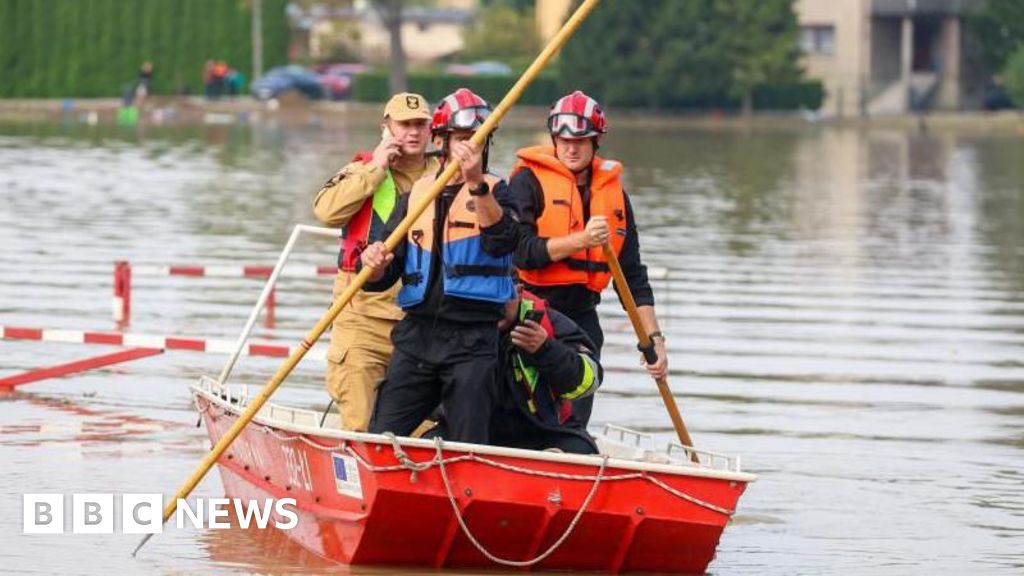This is an audio transcript of the FT News Briefing podcast episode: ‘Swamp Notes — Misinformation as a campaign strategy’
Sonja Hutson
Springfield, Ohio, is a city of around 60,000 people. For a long time, it was perhaps best known as the birthplace of Grammy Award-winning musician John Legend. But since the US presidential debate earlier this month, Springfield has been in the news for a very different reason.
Donald Trump’s voice clip
In Springfield, they’re eating the dogs. The people that came in, they’re eating the cats. They’re eating the pets of the people that live there.
Sonja Hutson
This is Swamp Notes, the weekly podcast from the FT News Briefing, where we talk about all of the things happening in the 2024 US presidential election. I’m Sonja Hutson. And this week we’re asking do American voters care about the truth? Here with me to discuss is Joshua Chaffin. He’s the FT’s New York correspondent. Hi, Josh!
Joshua Chaffin
Hello.
Sonja Hutson
And we’ve also got Ed Luce, the FT’s US national editor and co-author of The Swamp Notes Newsletter. Hi, Ed!
Edward Luce
Hello.
Sonja Hutson
So, Ed, I want to start with you. We’re talking about misinformation today. Can you tell us a little bit about the conspiracy theory about Springfield and how it ended up as one of Donald Trump’s talking points during the presidential debate?
Edward Luce
Sure. This is the cats and dogs one that originated as so many of these things do with a random Facebook post. But it got picked up by one of the sort of heavily followed influencers on the far right and then quickly became a meme. People like Elon Musk then sort of rocket-boosting it with their own endorsements. And JD Vance, who is, you know, of the generation of online Republicans we should never forget the guy’s 40. He’s really been an active online Twitter conservative then, you know, turning it into an even bigger meme and then it finds its way into Donald Trump’s mouth. Donald Trump believes in truthful hyperbole. Truthful hyperbole being his description for strategic lying. And there something sounds like it might be true, you know, and that some people might believe it, then treat it as if it is true. And that is his modus operandi and has been for many years. This is just one example of it.
Sonja Hutson
Now, Josh, you visited Springfield after this theory started circulating. How has the town been impacted by all this new attention?
Joshua Chaffin
Springfield is like a small town, kind of every town that is in the grips of hysteria. And there is an element of it that is almost like The Simpsons, where the fictional town is called Springfield. But you can you know, it’s almost comical in some ways. The sight of it that’s not comical is you see these Haitian immigrants and there is real and legitimate fear. I mean, there are bomb threats that have been called into the city. There are people shouting things out the window of pick-up trucks as they go by, menacing things. And there’s a real fear that somebody will do something terrible.
Sonja Hutson
So I want to leave Springfield for a minute and talk about this on a wider scale. I mean, there are certainly lots of impediments to voters finding out the truth. We talked about some of them in our episode about America’s fractured media ecosystem that’s really developed over the last several years. But Ed, I want to go back to the question that I posed at the beginning of this episode, which is and you know, this is somewhat cliché in the Trump era, but does the truth matter to voters?
Edward Luce
Not that much, no. The reassuring sort of coda to that is it’s never matter that much, you know? It’s just that because of things you’ve discussed on recent podcasts and that brave new technological world wherein that has been this disintermediation not just of legacy media, as it’s called, but also the disintermediation of the parties. You know, you’ve now got a situation where the combination of gerrymandering and the sort of discrediting of the Republican establishment means the more outrageous you are, the more likely you are to get nominated. That’s why there are more Marjorie Taylor Greene in this world. There were just as many in the last world, but they just didn’t tend to become quite so easily. Republican lawmakers, elected Republican lawmakers.
So I suppose my answer to your question comes in two parts: No, in fact, truth is an actual obstacle to career advancement in the Republican party nowadays. But I believe it still matters at some degree in a general election where there is a non-gerrymandered-minded electorate. And that is true in states and it’s true in presidential elections. You cannot gerrymander states or presidential elections. I do believe this will matter and is mattering. And remember, in this presidential election — which is already under way — there are people voting in many early voting states, and some of those are the really critical states. So what’s happening now is influencing votes now, today.
Sonja Hutson
Yeah, it’s interesting that you mentioned the discrediting of the Republican establishment. You know, people that might otherwise try to hold someone like Trump accountable for lying, because we have actually seen some mainstream Republican officials — including Ohio’s governor — try to disabuse people of the Springfield conspiracy theory. Right, Josh? I mean, and has it had any effect from what you’ve seen?
Joshua Chaffin
You know, certainly less than I would have thought. And this is something that I find fascinating. It doesn’t really matter. Somebody had observed to me when I arrived in Springfield, you have the mayor and the police chief have very quickly kind of pointed out that this is not true. And it’s almost like this pernicious weed once it’s out there, that you just can’t get rid of it. And they’re sort of frantically trying to pull it up. You know, every place it pops up and it just keeps growing and spreading.
I’m amazed, I guess, that the many Trump rallies that have gone to, the power that Trump has had just repeating messages over and over and they become a kind of truth for people, even if they start out without any basis. And I guess that the deeper truth behind all this is Trump invents are saying, do you want black Haitians in your community? Do you want them coming to where you live? And I think politically, that’s the message that is getting through, at least to the people who are susceptible to that message.
Sonja Hutson
So I want to play a clip from a recent CNN interview with JD Vance, Donald Trump’s running mate, about Springfield.
JD Vance’s News clip
The American media totally ignored this stuff until Donald Trump and I started talking about cat memes. If I have to create stories so that the American media actually pays attention to the suffering of the American people, then that’s what I’m gonna do. Dana, because you guys are completely letting Kamala Harris . . .
Sonja Hutson
So Ed, is this the truthful hyperbole that you were talking about earlier? And how do you think this all fits into the Trump campaign’s electoral strategy?
Edward Luce
Vance It’s not stupid. I mean, he’s on record as saying before he became the nominee, a lot of stupid things. But what he just said isn’t stupid. It’s really cynical. Which is why, you know, if it serves our purpose doesn’t matter whether it’s true or not, it gets at some deeper underlying truth. He’s not just doing his boss’s bidding, which would be enough in itself to explain him echoing these lies. But I think he has a sort of darker, visceral hint about what impact this might be having on some voters. And if there is whatever the opposite of a silver lining is a dark lining to the exposure of this cats and dogs lie. It is that well, at least from Trump’s point of view, we are talking about immigration.
Immigration is an issue on which Trump leads by quite a lot. And even if it’s, you know, it’s the same principle. Better to have bad publicity than no publicity. They are on Trump’s turf. And as Josh rightly pointed out, the real issue here is really, do you want black Haitians living in your community? And so we could be underestimating the degree to which this is at some level beneficial to Trump-Vance.
Joshua Chaffin
I would add that in terms of the mainstream media is neglecting Springfield. You go back through the clips and I saw some really rich, deep reporting about the plight of Springfield. This is before the dog and cat story. About the plight of a rustbelt town that has tried desperately to make a comeback. And actually, the Haitians’ arrival is, perhaps, unexpected consequence of the town’s success. You know, all of that, which I think is fascinating, hopefully for FT readers, is not the kind of thing that you would probably hear about at a presidential debate or on the campaign trail.
Sonja Hutson
Just to wrap up, I want to ask kind of a big picture question, which is, does this phenomenon of politicians so brazenly spreading misinformation? I mean, you have JD Vance going on CNN and talking about how he knows he’s spreading a lie and feels good about doing that. Does that feel like something that can be at all put back into the bottle? You know, Ed, you said earlier that this is nothing new, but could it get worse or could it continue even after Trump leaves the political scene?
Edward Luce
No, I think I mean, I’ve always thought Trump has a very, very specific and sort of irreplaceable symptom of a sort of deeper malaise about or loss of confidence in American. The American creed that you’ve seen in parts of the population. And therefore, I think forms of that will outlast Trump. And I mean, at the moment, I am expecting Trump to lose in November. I mean, very marginal expectation, which could easily flip the other way. But should he lose . . .
Sonja Hutson
Predicting an election is a dangerous game these days, Ed. (Laughter)
Edward Luce
That’s why I immediately unpredicted my prediction. But, you know, Vance was chosen very clearly with the future in mind. And, you know, there’s a lot of money behind Maga continuing. I wouldn’t write it off.
Joshua Chaffin
I agree with that, that Trump is kind of singular. But am sad to say as a mainstream reporter, I think this is here to stay. And I don’t see it being put back in the bottle.
Sonja Hutson
All right. We’re gonna take a quick break. And when we come back, we’ll do Exit Poll.
[WIRED POLITICS LAB PODCAST TRAILER PLAYING]
Sonja Hutson
And we are back with Exit Poll where we talk about something that did not happen on the campaign trail and apply rigorous political analysis to it. Ben & Jerry’s is a beloved American ice cream brand famous for somewhat eccentric flavours like Goodbye Yellow Brick Road in honour of Elton John or Yes, Pecan — depending on how . . . that’s a very controversial pronunciation — that’s in honour of Barack Obama. And this week they unveiled Kamala’s Coconut Jubilee, named after Kamala Harris and the famous you-think-you-just-fell-out-of-a-coconut-tree meme. It has coconut ice cream with a caramel swirl and star shaped sprinkles. So what do you both think that a Donald Trump-flavoured ice cream would include? And bonus points if you have a name to go along with it?
Edward Luce
Yeah, I mean, there’s a reason why I went into journalism and not marketing. (Laughter) The favourite thing of mine that Trump has said in recent weeks is I hate Taylor Swift. It was just . . .
Sonja Hutson
In all caps!
Edward Luce
In all caps. After she endorsed Kamala Harris and Tim Walz. And he’s kind of obsessed with her and he’s kind of obsessed with a romantic life, he’s obsessed . . . So I like a play on Taylor Swift, something like ‘Taylor humble pie’. And I would like it to have all the worst ingredients because he’s gonna be forced to eat his ‘Taylor humble pie’.
Joshua Chaffin
Mine would be called ‘Megalicious’. It would be ice cream with kind of gold leaf and it would be full of nuts and it would be served atop a Roy Cohn.
Edward Luce
And that’s good.
Sonja Hutson
All right. Well, I want to thank our guests, Joshua Chaffin, he’s the FT’s New York correspondent. Thanks, Josh.
Joshua Chaffin
Thank you.
Sonja Hutson
And Ed Luce, he’s our US national editor and columnist. He also is the co-author of The Swamp Notes newsletter. Thanks, Ed.
Edward Luce
Always a pleasure.
[MUSIC PLAYING]
Sonja Hutson
This was Swamp Notes, the US politics show from the FT News briefing. If you want to sign up for the Swamp Notes newsletter, we’ve got a link to that in the show notes.
Our show is mixed and produced by Ethan Plotkin. It’s also produced by Lauren Fedor and Marc Filippino. Special thanks to Pierre Nicholson. I’m your host, Sonja Hutson. Our executive producer is Topher Forhecz, and Cheryl Brumley is the FT’s global head of Audio. Original Music by Hannis Brown. Check back next week for more US political analysis from the Financial Times.








































































































































You must be logged in to post a comment Login